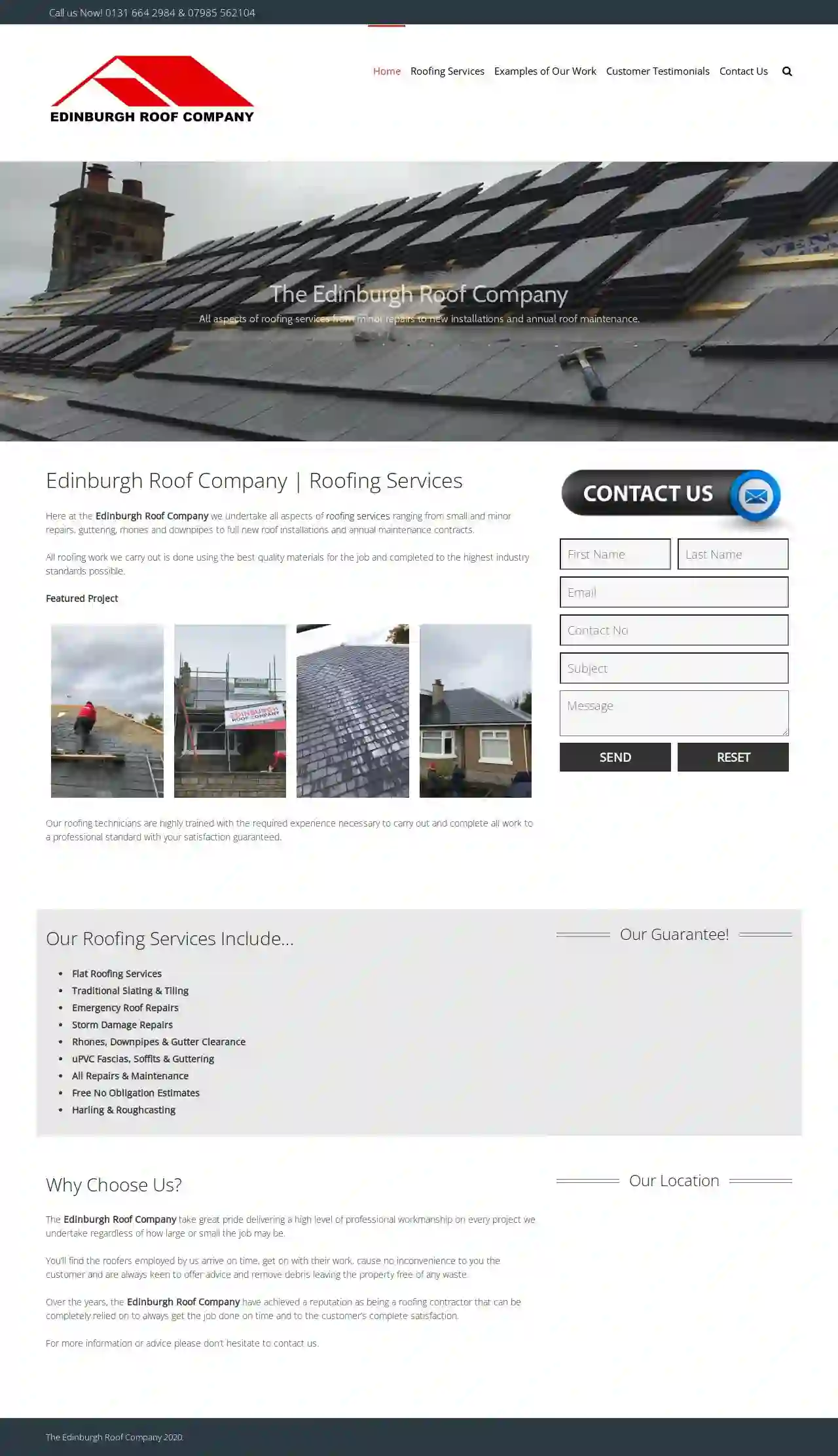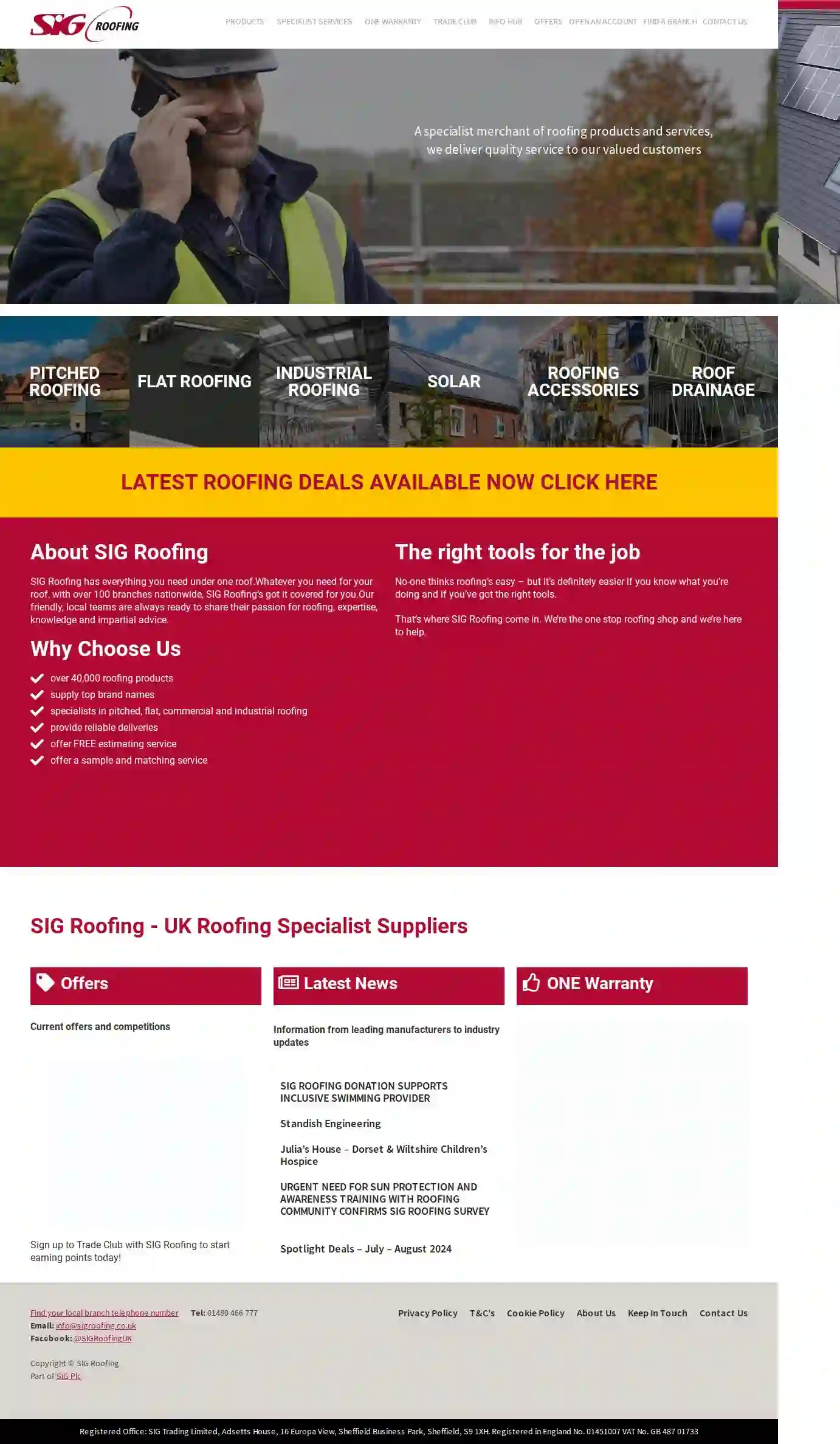Roofing Companies Cockenzie
Find the best Roofers in Cockenzie
Get multiple Roofing Company quotes for your project today! Compare profiles, reviews, accreditations, portfolio, etc... and choose the best service.

Lynks Serivces Buidling and Height Services
52 reviewsEdinburgh, GBWe are a company providing rope access and building services.
- Services
- Why Us?
- Gallery
Get Quote
Stuart & Moffat Roofing Contractors - Edinburgh
53 reviewsUnit 44, Mayfield Industrial Estate, Dalkeith., Dalkeith, EH22 4AD, GBStuart & Moffat Roofing is a trusted roofing company in Edinburgh, providing a full range of roofing services including roof replacement, roof repair, flat roofs, chimney work, Velux windows, gutters and downpipes. Established in 2019, our Directors Danny and Malcolm have over 20 years’ experience in delivering roofing excellence and share a passion for customer care. We serve East Lothian, Midlothian & Edinburgh. No job is considered too big or too small. When you get in touch, we will arrange a free photographic survey of your roof and then provide you with a detailed quotation. All our work is carried out to the highest standard of workmanship with meticulous attention to detail. We are fully insured, all of our new roofs come with a full guarantee and we provide a comprehensive after care service to give you complete peace of mind. As experienced roofers, we know that when you have roof problems they need to be dealt with quickly to minimise any internal damage to your property. That is why we believe clear transparent communication is essential so that you know exactly what is happening and when. We also understand how much of an inconvenience roof repairs or roof replacement can be for clients. For this reason, we will work efficiently and tirelessly to ensure that disruption is kept to an absolute minimum during the entirety of the project.
- Services
- Why Us?
- Accreditations
- Our Team
- Testimonials
- Gallery
Get Quote
Edinburgh Roof Company
4.634 reviewsEdinburgh, Scotland, 123 Main Street, EH1 1AA, GBThe Edinburgh Roof Company is a professional roofing contractor that provides all aspects of roofing services from minor repairs to new installations and annual maintenance contracts. Our team of experienced roofers are highly trained and equipped to handle any roofing job, big or small. We take pride in delivering a high level of professional workmanship on every project we undertake, ensuring that our customers receive the best possible service. Our services include flat roofing, traditional slating and tiling, emergency roof repairs, storm damage repairs, rhones, downpipes and gutter clearance, uPVC fascias, soffits and guttering, all repairs and maintenance, and free no obligation estimates. We also offer harling and roughcasting services. Our guarantee ensures that our customers can rely on us to get the job done on time and to their complete satisfaction.
- Services
- Why Us?
- Gallery
Get Quote
FIFE ROOF MAINTENANCE
541 reviewsBoreland Rd, Kirkcaldy, KY2 6JL, GBFife Roof is a family-run company committed to customer care and ensuring our services are delivered to the very highest standard. With over 30 years of experience in roofing repairs and installation, we offer a wealth of services including flat roofing, tiled roofing, slate roofing, and roofline repairs. We are proud of our reputation for quality and welcome enquiries from all customers, no matter what the size of the job or where you are in the region. We are a long-established company providing affordable services to many customers across Fife.
- Services
- Why Us?
- Gallery
Get Quote
Absolute Roofing
2.52 reviewsEdinburgh, EH, GBAbsolute Roofing & Building Ltd. are an Edinburgh based company that specialise in all aspects of roofing and building. Our staff are all fully qualified tradesman who pride themselves in the quality of their workmanship. We undertake projects on both Private and commercial properties in Edinburgh and the Lothians. We are more than happy to meet with you to take a look at your roof and give you a free quote.
- Services
- Why Us?
Get Quote
Traditional Roofing & Building
4.969 reviews4 Station Brae, Edinburgh, EH15 1LQ, GBTraditional Roofing and Building Ltd, based in Edinburgh are premier roofing contractors. Highly regarded for our expert roofing and building services. We undertake all Residential and Commercial work. Renowned for quality craftsmanship, the company has garnered an impressive reputation, with accolades such as the NFRC Scottish Roofing Award highlighting our commitment to excellence. We're Fully Insured – £5 Million Public & £10 Million Employer's Liability Insurance Our team's professionalism and skill are underlined by their rigorous training and dedication to maintaining high industry standards. For anyone in Edinburgh or the Lothians seeking reliable roofing solutions, Traditional Roofing and Building Ltd promises unmatched quality and customer satisfaction, backed by a robust portfolio of successfully completed projects. Traditional Roofing and Building are award winning Edinburgh roofers and building contractors. One of the finest roofing companies serving residents throughout Edinburgh and the Lothians. You can rely on us for all roof maintenance services including emergency roof repairs. We cover a wide range of services including small and minor repairs to full roof installations and building projects. Our expert roofers are highly trained in all types of work. In addition, we provide free roof advice, inspections, and estimates for any type of residential or commercial project. Our services include flat roofs, traditional slating and tiling, single ply systems. We also welcome all emergency repairs, chimney work, and stonework to building maintenance to complete re-roof projects. Above all, we are NFRC Award-Winning roof contractors. Our highly trained roofers provide professional roofing services to all our customers. As roofing contractors, we are highly regarded as being one of the best companies in Edinburgh. Our staff work to very high industry standards because we employ the best roofers with skill and experience. In conclusion, the finished work is guaranteed. We welcome all roof maintenance projects, repairs, and conservation for any type of property. Please view our site for examples of projects we have recently completed and the high quality of workmanship we carry out.
- Services
- Why Us?
- Accreditations
- Gallery
Get Quote
Hallmark Roofing
4.713 reviews62 Pirniefield Place, Edinburgh, EH67PR, GBWelcome to Hallmark Roofing Edinburgh Ltd. We cover all aspects of roofing in Edinburgh and the Lothians. Specialising in leadwork, slating/tiling and flat roofs. Our Services We take great pride in the standard of every job, however big or small. We take the time to get to know every client for a better understanding of what they want and to provide a personal experience. That way the client can relax knowing that the job is in good hands and completed to their expectations. Give your roof the stamp of approval today! For more information about our services, or for a free estimate, please call 0131 235 2933 or Daryl on 07934059984, email [email protected]
- Services
- Why Us?
- Our Team
- Gallery
Get Quote- G.
G.D.M Roofing
51 reviews123 Main St, Suite 456, Los Angeles, 90210, GBGDM Roofing is a locally owned and operated roofing company serving the greater [City Name] area. We specialize in residential and commercial roofing services, including new roof installations, repairs, and maintenance. Our team of experienced and certified roofers is dedicated to providing high-quality workmanship and exceptional customer service. We use only the best materials and techniques to ensure that your roof is protected for years to come.
- Services
- Why Us?
- Gallery
Get Quote 
Slate Surgeons Ltd
59 reviewsEdinburgh, GBLocal, affordable, reliable roofing 07840240373 [email protected] Edinburgh ◇ East Lothian ◇ Midlothian ◇ ROPE ACCESS ROOFING AND BUILDING REPAIRS We take great pride in our personal and caring approach to customer relationships. We fully understand how nerve-wracking it can be to own a roof, never mind needing to call in a roofer. There is nothing we like more than seeing the relief on faces when we fix a leak or advise on a repair. It’s rarely as bad as you think it is. Our Vision Our main aim is to give you confidence in your roof. Careful repair, restoration and maintenance will prolong the life of your roof. We will never recommend unnecessary work or over charge. Precision roofing Emergency repair Rope access Leak diagnostics Roof survey Gutter and downpipe General Maintenance Contact us today for a free no obligation quote [email protected] 07840240373 Facebook Instagram Whatsapp chat on 07816506160 Slate Surgeons Ltd, Blog at WordPress.com. Privacy Slate Surgeons Ltd
- Services
- Why Us?
- Gallery
Get Quote
SIG Roofing Edinburgh
4.417 reviewsNA, GBSIG Roofing is a specialist merchant of roofing products and services, delivering quality service to our valued customers. Established for over 40 years – with branches throughout the UK from Inverness to Plymouth. We have everything you need under one roof. Whatever you need for your roof, with over 100 branches nationwide, SIG Roofing’s got it covered for you. Our friendly, local teams are always ready to share their passion for roofing, expertise, knowledge and impartial advice.
- Services
- Why Us?
- Accreditations
- Our Team
- Testimonials
- Gallery
Get Quote
Over 12,314+ Roofers on our directory
Our roofing pros operate in Cockenzie and beyond!
Roofyng.co.uk has curated and vetted Top Roofing Businesses in and around Cockenzie. Find the most reliable business today.
Frequently Asked Questions About Roofing Companies
- Experience: 'How long have you been in business, and what experience do you have with similar projects?'
- Licensing and insurance: 'Are you licensed and insured, and can I see proof of coverage?'
- Warranties: 'What warranties do you offer on your work and the materials used?'
- References: 'Can you provide references from past clients?'
- Project Timeline: 'What is the estimated timeline for completing the project?'
- Payment Terms: 'What are your payment terms, and do you require a deposit?'
- Communication: 'How will you keep me updated on the project's progress?'
- Cleanup: 'What steps will you take to protect my property during the project and ensure proper cleanup afterward?'
- Hot Climates: Opt for light-colored or reflective roofing materials to reduce heat absorption. Consider tile roofs for their thermal mass and heat resistance.
- Cold Climates: Ensure your roof has adequate insulation and ventilation to prevent ice dams and moisture buildup. Metal roofs can shed snow effectively.
- High-Wind Areas: Choose roofing systems with high wind ratings and properly installed hurricane straps or clips to enhance wind resistance.
- Areas with Heavy Rainfall: Ensure your roof has proper drainage and a waterproof membrane to prevent leaks.
- Roof size and complexity
- Roofing material chosen
- Local labor costs
- Accessibility of the roof
- Removal of existing roofing
- Additional features (skylights, chimneys, etc.)
What is fascia, and why is it important?
What questions should I ask a roofing contractor?
How do I choose the right type of roof for my climate?
How much does a new roof cost in the UK?
What is fascia, and why is it important?
What questions should I ask a roofing contractor?
- Experience: 'How long have you been in business, and what experience do you have with similar projects?'
- Licensing and insurance: 'Are you licensed and insured, and can I see proof of coverage?'
- Warranties: 'What warranties do you offer on your work and the materials used?'
- References: 'Can you provide references from past clients?'
- Project Timeline: 'What is the estimated timeline for completing the project?'
- Payment Terms: 'What are your payment terms, and do you require a deposit?'
- Communication: 'How will you keep me updated on the project's progress?'
- Cleanup: 'What steps will you take to protect my property during the project and ensure proper cleanup afterward?'
How do I choose the right type of roof for my climate?
- Hot Climates: Opt for light-colored or reflective roofing materials to reduce heat absorption. Consider tile roofs for their thermal mass and heat resistance.
- Cold Climates: Ensure your roof has adequate insulation and ventilation to prevent ice dams and moisture buildup. Metal roofs can shed snow effectively.
- High-Wind Areas: Choose roofing systems with high wind ratings and properly installed hurricane straps or clips to enhance wind resistance.
- Areas with Heavy Rainfall: Ensure your roof has proper drainage and a waterproof membrane to prevent leaks.
How much does a new roof cost in the UK?
- Roof size and complexity
- Roofing material chosen
- Local labor costs
- Accessibility of the roof
- Removal of existing roofing
- Additional features (skylights, chimneys, etc.)